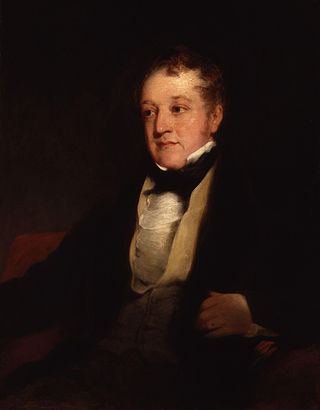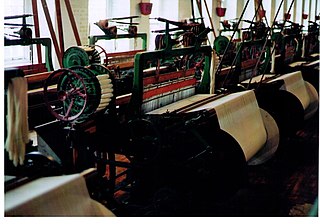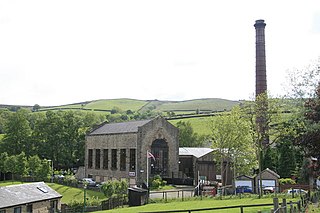Related Research Articles

William Huskisson was a British statesman, financier, and Member of Parliament for several constituencies, including Liverpool.

Blackburn is an industrial town and the administrative centre of the Blackburn with Darwen borough in Lancashire, England. The town is north of the West Pennine Moors on the southern edge of the Ribble Valley, 8 mi (13 km) east of Preston and 21 mi (34 km) north-northwest of Manchester. Blackburn is the core centre of the wider unitary authority area along with the town of Darwen. It is the second largest town in Lancashire.

The spinning jenny is a multi-spindle spinning frame, and was one of the key developments in the industrialisation of textile manufacturing during the early Industrial Revolution. It was invented in 1764–1765 by James Hargreaves in Stan hill, Oswaldtwistle, Lancashire in England.

A power loom is a mechanized loom, and was one of the key developments in the industrialization of weaving during the early Industrial Revolution. The first power loom was designed and patented in 1785 by Edmund Cartwright. It was refined over the next 47 years until a design by the Howard and Bullough company made the operation completely automatic. This device was designed in 1834 by James Bullough and William Kenworthy, and was named the Lancashire loom.

Textile manufacture during the British Industrial Revolution was centred in south Lancashire and the towns on both sides of the Pennines in the United Kingdom. The main drivers of the Industrial Revolution were textile manufacturing, iron founding, steam power, oil drilling, the discovery of electricity and its many industrial applications, the telegraph and many others. Railroads, steamboats, the telegraph and other innovations massively increased worker productivity and raised standards of living by greatly reducing time spent during travel, transportation and communications.

Westhoughton Mill or Rowe and Dunscough's Mill, in Mill Street in Westhoughton, near Bolton in the historic English county of Lancashire, was the site of a Luddite arson attack in 1812. The mill was built in 1804 by Richard Johnson Lockett, a Macclesfield man who lived at Westhoughton Hall. He leased the mill to Thomas Rowe of Manchester in 1808.
Events from the year 1826 in the United Kingdom.

Howard & Bullough was a firm of textile machine manufacturers in Accrington, Lancashire. The company was the world's major manufacturer of power looms in the 1860s.

A weavers' cottage was a type of house used by weavers for cloth production in the putting-out system sometimes known as the domestic system.

The Lancashire Loom was a semi-automatic power loom invented by James Bullough and William Kenworthy in 1842. Although it is self-acting, it has to be stopped to recharge empty shuttles. It was the mainstay of the Lancashire cotton industry for a century.

Burnley Barracks was a military installation at Burnley in Lancashire, England. Built for cavalry, but later used for infantry and storage, military activities at the barracks declined in the late 19th century.
The Calton weavers were a community of handweavers established in the community of Calton, then in Lanarkshire just outside Glasgow, Scotland in the 18th century. In 1787 the weavers went on strike. Troops opened fire on the demonstrators and six weavers were killed. In the early 19th century, many of the weavers emigrated to Canada, settling in Carleton Place and other communities in eastern Ontario, where they continued their trade.

Harle Syke is a small village within the parish of Briercliffe, situated three miles north of Burnley, Lancashire, England. It was the home to eleven weaving firms, working out of seven mills. Queen Street Mill closed in 1982, and was converted to a textile museum, preserving it as a working mill. It is the world's last 19th-century steam powered weaving mill.

The Preston Strike and Lune Street Riot, which took place in Preston, in Lancashire, England over 12 and 13 August 1842, were part of the 1842 General Strike or ‘Plug Plot Riots’. These strikes and disturbances were prompted by depression in 1841–1842 which resulted in wage cuts of over 25%.

Bancroft Shed was a weaving shed in Barnoldswick, Lancashire, England, situated on the road to Skipton. Construction was started in 1914 and the shed was commissioned in 1920 for James Nutter & Sons Limited. The mill closed on 22 December 1978 and was demolished. The engine house, chimneys and boilers have been preserved and maintained as a working steam museum. The mill was the last steam-driven weaving shed to be constructed and the last to close.
Piece-rate lists were the ways of assessing a cotton operatives pay in Lancashire in the nineteenth and early twentieth centuries. They started as informal agreements made by one cotton master and their operatives then each cotton town developed their own list. Spinners merged all of these into two main lists which were used by all, while weavers used one 'unified' list.

Harle Syke mill is a weaving shed in Briercliffe on the outskirts of Burnley, Lancashire, England. It was built on a green field site in 1856, together with terraced houses for the workers. These formed the nucleus of the community of Harle Syke. The village expanded and six other mills were built, including Queen Street Mill.
William Horrocks, a cotton manufacturer of Stockport built an early power loom in 1803, based on the principles of Cartwright but including some significant improvements to cloth take up and in 1813 battening.
Ellen Hooton was a ten-year-old girl from Wigan who gave testimony to the Central Board of His Majesty's Commissioners for inquiring into the Employment of Children in Factories, 1833. She had been working for several years at a spinning frame, in a cotton mill along with other children. She worked from 5.30 am till 8 pm, six days a week and nine hours on a Saturday. She absconded at least 10 times and was punished by her overseers.
The handloom industry in Tangail is one of the oldest cottage industries in Bangladesh. This traditional saree is produced in Tangail district and is named after the place.
References
Citations
- ↑ Aspin (1995), p. 63
- ↑ Poole, Robert (April 2009), "French Revolution or Peasants' Revolt?", Labour History Review, 1, 74
- ↑ Aspin (1995), p. 64
- 1 2 Aspin (1995), pp. 67–69
- ↑ Bauer (1997), p. 69
- ↑ Aspin (1995), pp. 68–69
- ↑ Aspin (1995), p. 70
Bibliography
- Aspin, Chris (1995), The First industrial Society: Lancashire 1750–1850, Carnegie Publishing, ISBN 9781859360163
- Bauer, Martin (1997), Resistance to New Technology: Nuclear Power, Information Technology and Biotechnology, Cambridge University Press, ISBN 9780521599481